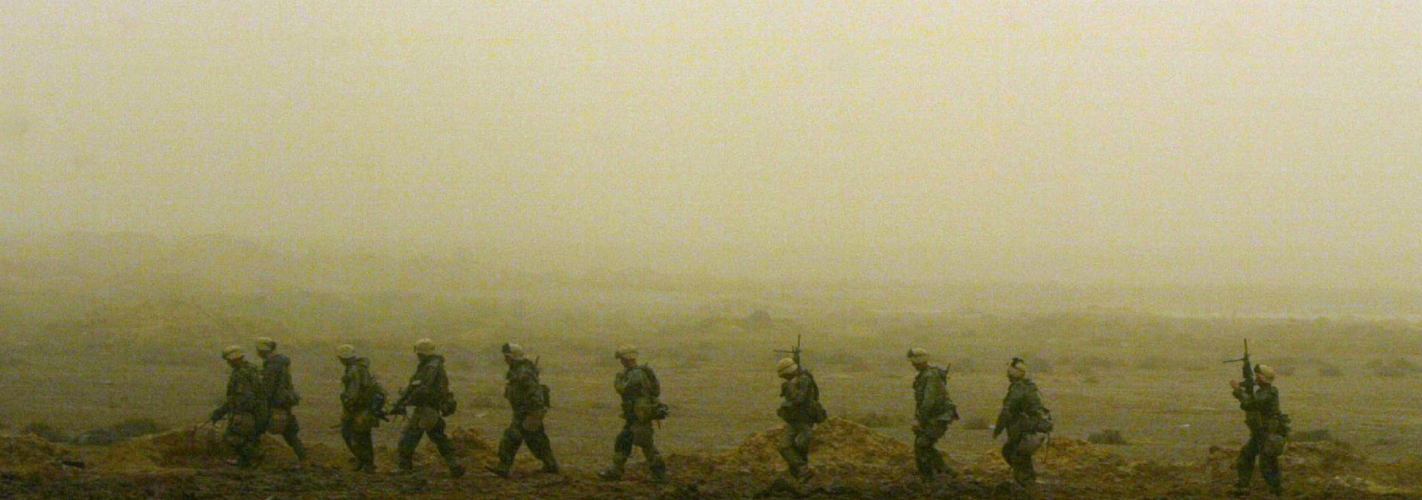“A foreign policy venture under the sway of the Iranian militias and the resurgence of the Islamic State”
Background
Iraq, for nearly two decades, since the fall of the Iraqi regime in 2003, has been engaged in a series of battles on the political, security, economic and social levels. However, the security situation remains the most critical and dangerous issue along the line. The state of insurgency and the spread of terrorist organizations, armed groups, foreign and domestic militias, state-sponsored organized crime groups, and rampant corruption are the main destabilizing elements that hinder building a strong and empowered government in Iraq.
The United States was on the verge of achieving a lasting victory in the war on terrorism that took place in Iraq after the fall of the Iraqi regime in 2003. In 2006, Al Qaeda in Iraq (AQI) had lost its leader and the mastermind of the organization, Abu Musab al-Zarqawi. Over the next few years, Al-Qaeda in Iraq (AQI) lost its territorial dominance as Iraq’s Sunni tribes turned against it and began fighting beside U.S. and Iraqi forces to expel AQI members from northern and western Iraq. By 2010, Iraq had emerged from its civil war and AQI, as an organization, had collapsed. the U.S. continued presence in Iraq was essential to ensure the enduring defeat of AQI. However, The U.S. administration under President Barack Obama made two strategic mistakes that resulted in reversing all the progress that has been achieved over the years, sending Iraq spiraling back down the path of sectarian violence.
First, the Obama administration engaged in brokering a power-sharing deal that essentially reinstated Nouri al-Maliki as Prime Minister after his electoral defeat by a predominantly Sunni political coalition in Iraq’s 2010 parliamentary elections. This deal was a political and security earthquake that hit the fragile foundation of Iraqi democracy and disenfranchised the Sunni community, whose cooperation during the “Sunni Awakening” and “The Tribal Forces Command” earlier, had been so critical to ending Iraq’s cycle of violence and defeating AQI in the north and west of Iraq. Second, the administration mishandled the withdrawal of U.S. forces in 2011, which seems to be a common practice nowadays, leaving the Sunni communities vulnerable and the Iraqi security forces unprepared to take responsibility for the country’s security. Almost simultaneously, a civil war broke out in Syria. The remnants of AQI—under new leadership and a new banner, the Islamic State in Iraq and Syria (ISIS)—exploited the conflict to reemerge in the form of a state “Caliphate”.
The Sunni community began fighting back against the oppression, marginalization, and assassination campaigns that Nouri al-Maliki’s government carried out against the Sunnis in Diyala, Nineveh, Saladin, and Anbar provinces. In 2013, the Sunnis rose up against Maliki’s government, forming a tribal coalition and tribal forces in order for the local population to provide security for their cities and provinces and to prevent Maliki’s government from pursuing the demographic change and displacement campaigns that had been conducted through special units of Iraqi Forces with ties to the Iranian Revolutionary Guard Corps (IRGC) and Maliki’s inner circle. The Sunni demonstration was infiltrated by local members and leaderships of ISIS, millions of dollars were injected into the demonstrations by wealthy individuals sponsored by regional countries to enable ISIS back into Anbar province and facilitate the seize of nearly a third of Iraq’s territory.
The Return to Iraq
After the faulty withdrawal of U.S. troops from Iraq in 2011, The U.S. troops returned to Iraq again in 2014, at Baghdad’s request, to lead the international coalition against the Islamic State (ISIS), which had taken control of large parts of northern and western Iraq. The U.S. presence in Iraq has been challenged by different Shiite militias and armed groups sponsored by the Islamic Republic of Iran. Several militias have been organized under the organizational structure of the Popular Mobilization Forces (PMF) AKA; Popular Mobilization Units (PMU), this structure (PMU) was catastrophically underestimated by many military and intelligence institutions, both regionally and internationally. As soon as the Iraqi Government declared victory over ISIS in 2017, the PMU was subsequently classified by the Iraqi Government (under Tehran’s pressure) as an official government organization. The PMU committee has also been recognized as an active political entity that participated in the parliamentary elections in 2018 and 2021. The PMU was Iran’s Trojan horse in Iraq and into the region.
The U.S. presence in Iraq has been challenged by many Iranian-sponsored militias, where U.S. diplomatic missions, U.S. military bases, facilities, and other installations were numerously attacked by rockets, drones, and explosives. Intelligence reports indicated that many of the major attacks were under the direct supervision of the former commander of the Iranian Revolutionary Guard Corps – Quds Force (IRGC-QF), Gen. Qassim Soleimani. Soleimani was killed in a U.S. drone attack in January 2020, near Baghdad International Airport (BIA).
In recent months, U.S. troops have pulled out of eight (8) publicly known bases in Iraq, most of which were vulnerable to attacks by Iranian-sponsored armed groups and other terrorist organizations. Several command posts have been downgraded in terms of leadership presence, and others were transferred to neighboring countries such as Kuwait and other locations in the region.
In December 2021, the U.S. military announced it had ended its combat mission in Iraq. The development came after a series of meetings between the U.S. military and Iraqi officials and was concluded with a meeting between the Iraqi Prime Minister (Kadhimi) and President Biden, followed by an announcement that “there will be no U.S. forces with a combat role in Iraq by December 31, 2021”.
“The U.S. mission in Iraq is simply between the hammer (Drones-Rockets) of the Iranian-sponsored militias and the anvil of the Islamic State (ISIS) terrorism.”
The Resurgence of the Islamic State (ISIS)
Despite the defeat of the Islamic State (ISIS) militarily and the collapse of the group’s organizational structure, the threat remains at its highest levels by all military and operational measures since the terrorist organization (ISIS) is known for its unique experience in operating in a decentralized clustered structure and that alone is a serious challenge the coalition forces have been facing for years, especially after the reduction of U.S. presence in Iraq and the reduction in combat-related activities.
The Islamic State (ISIS) has regrouped in Iraq in a rapid manner and began to carry out attacks in a geographical territory that is politically and ethnically sensitive and characterized by two factors ; (I) being either areas with sectarian and ethnic overlap, such as Diyala Province, which extends to the northeast of Baghdad as far as the Iranian border from one side and connects to Saladin Province; AKA: Salah ad-Din Governorate in the northern part, as well as Kirkuk, and Sulaymaniyah Provinces in the Kurdistan Region (KRI), or (II) areas that are politically and administratively disputed, where the security effort is dispersed like the disputed areas between the Kurdistan Region (KRI) and the rest of the territories that the central government administratively controls.
The apparent shift in the Islamic State’s (ISIS) attacks shows a qualitative and quantitative pattern of operations and a remarkable transition from direct confrontation to sporadic (hit-and-run) attacks that are characterized by rapid execution and tactical retreat. The re-emergence of ISIS at this time is not a coincidence. It is clearly associated with the escalation of political tension that followed the recent elections in Iraq, in which Muqtada al-Sadr’s movement gained a noticeable majority that the Iranian regime did not take into account.
Additionally, the re-emergence of ISIS has always been associated with specific events and acute crises. Local sources and field experts have indicated that the sudden increase in ISIS operational activities is linked in one way or another to the Iranian role in Iraq and the region. The simultaneous emergence cannot be described except as a beneficial factor that Tehran exploits to pass certain political decisions or as an element of pressure. ISIS resurgence is a tool through which the Iranian-sponsored militias can achieve a broader scope of control and a greater extent of gain at the military and strategic levels by pushing the Shiite-dominated Popular Mobilization Forces (PMU) to the scene once again and opening the door for the Iranian-sponsored militias to fill the security vacuum in Iraq, especially after the end of the U.S.-led coalition forces’ combat missions in Iraq and the withdrawal of U.S. forces.
“The resurgence of the Islamic State “ISIS” in Iraq is Iran’s insurance policy and the luxurious yacht to safety.”
The Timing Factor
The Islamic State (ISIS) is a necessity when it comes to serving Iran’s interests, regardless of the media hype that promotes Iran’s dedicated role in fighting ISIS in the region, specifically Iraq and Syria.
Iran’s role in fueling the bloody conflict in the Middle East and beyond is a proven fact, and that Iran has been, and still is, the primary sponsor of armed groups, sectarian militias, and terrorist organizations is undebatable. Additionally, for almost 20 years, the Iranian regime has been a safe-haven and a forward base, through which terrorist organizations such as “Al-Qaeda” (AQ), the former “Jama’at al-Tawhid wal-Jihad” (Zarqawi’s Primary Network), Al-Qaeda In Iraq (AQI), and more recently the Islamic State (ISIS). These terrorist organizations and other Shiite militias have carried out attacks against neighboring countries, U.S. led coalition forces, U.S. troops, and international missions and organizations in Iraq and the region for the past two decades. It is also important to note that the Islamic State (ISIS) has initially originated from the remnants of Al-Zarqawi’s network, which was Iran’s striking arm against the Iraqi Shiite Nationalists and those who refused to be loyal to Iran in the early years after the invasion of Iraq in 2003.
The “False Flag” operations and deceptive tactics are popular trades that the Iranian regime masters by heart. The Iranian Revolutionary Guard Corps – Quds Force (IRGC-QF) intelligence unit has always turned to similar tactics in operations of critical and sensitive natures. At a certain stage, the Quds Force (QF) reached the point of imposing “ISIS” on Lebanon in order to intimidate the Christians in Lebanon and promote Hezbollah as the leading provider of political discourse and as a preserver of minorities in the region, more specifically the Christian communities in Lebanon and Syria at the same time. In Yemen, Iran has been actively involved in providing all types of military assistance, intelligence support, and logistics to the Houthis to destabilize the region’s political and sectarian demographics in support of Iran’s geostrategic expansion aspirations.
Iran is determined to drag Iraq and the region into another crisis and to revive the opportunity to present the same and only remedy available, the Iranian-sponsored militias through the popular mobilization (PMU). The Iranian regime’s desire to reinforce and empower the PMU to be an official sponsor of the Islamic Republic’s interests in Iraq continues, amid from one side at copying the concept of Hezbollah in Iraq politically and militarily turning the Popular Mobilization (PMU) into another copy of the Iranian Revolutionary Guards (IRGC).
However, the urgency began to appear clearly after the results of the Iraqi elections, which came in contrast to what Iran had in mind. The results of the recent Iraqi elections did not suit Iran, despite the volatile positions of Muqtada al-Sadr, who has become the largest parliamentary bloc in the new parliament. It turns out, at least for the time being, that Al-Sadr decided to walk a line independent of the Islamic Republic. It is not known how long Al-Sadr will continue to adhere to this line, but all the recent Iraqi developments indicate that the Shiite Clerk (Muqtada Al-Sadr) appears determined to adopt a line independent of Iran based on his rejection of the loose and chaotic existence of the armed militias, and their uncontrolled domination.
Such a concept is in complete conflict with the Iranian approach to reproduce the experience of the “Revolutionary Guard” in Iraq through the Popular Mobilization (PMU), which, from the point of view of the Islamic Republic, embodies the future it sees for Iraq; an extension to Iran’s Islamic Revolutionary System and a bridge, through which Iran can transfer the principle and ideology of “Wilayat al-Faqih” (Guardianship/custodianship of the Shiite-Islamic jurist over the nation) to the rest of the countries in the region and beyond.
It is vitally important for the subject matter experts, whether those involved in U.S. foreign policy, the intelligence community or the think-tanks that influence Washington’s decision-making process to realize that Iran did not make all these efforts in order to be defeated in the Iraqi elections and to be confronted by a figure like Al-Sadr. The Popular Mobilization (PMU) was not created so that there would come a day for Iraqi politicians and legislators to control the armed groups and limit the legitimacy in the form of an officially elected government (even if that government’s sovereignty and legitimacy were imperfect). As a result, the re-emergence of ISIS has become an Iranian necessity in order to prevent the elections from becoming another step on the road to restoring the country’s character and nothing more.
“The new U.S. mission in Iraq is critically challenging, and will require a great deal of (inter-agency) cooperation and coordination; diplomacy must be in full alignment with both the military option and intelligence efforts.”
The New U.S. Mission and Approach
The U.S. position from Iran’s nuclear deal and Vienna’s negotiations, the administration’s decision to withdraw from the region gradually, the catastrophic withdrawal from Afghanistan, and the disastrous handling of the aftermath both militarily and diplomatically were interpreted as signs of significant weakness, inability, and loss in the U.S. administration’s ability to maintain a stable position or to keep the deep-rooted strategic alliances under the leadership of Biden’s administration. The U.S. administration has sent all the wrong signals at the wrong time, to Iran at first, and eventually to the U.S.’ most pivotal Middle Eastern and European allies.
There is no doubt that Iraq, in the coming days, will witness an enormous amount of attacks on highly sensitive targets, militarily installations, major energy facilities, diplomatic missions, and certain ethnically and religiously sensitive areas, all in conjunction with repeated attacks and temporary territorial prevalence by the Islamic State (ISIS) in the areas bordering the Kurdistan region (KRI), and in areas with a Sunni majority.
The new U.S. mission in Iraq is critically challenging and will require a great deal of (inter-agency) cooperation and coordination at the U.S. government level as well as other local and regional resources. In other words; The diplomatic mission must be in complete alignment with both the military option and intelligence efforts. Otherwise, the failure can be devastating, and the implications will not be confined to Iraq or the region only but far beyond that. The U.S. mission in Iraq is simply between the hammer (drones-rockets) of the Iranian-sponsored militias and the anvil of the Islamic State (ISIS) terrorism.
A continued U.S. presence in Iraq is essential to ensure the enduring defeat of the Islamic State (ISIS). The withdrawal of U.S. troops will result in a major blow to the war on terrorism; ISIS can still deliver painful attacks to vital facilities and strategic targets. The quantity and severity of the attacks would increase rapidly in the coming days due to several factors, the most important of which is first; Tehran’s position from the Iraqi elections’ results, second; the absence of U.S. and coalition support, and third; lack of quality intelligence; Activity-Based Intelligence (ABI) is highly essential at this point, and with the U.S. military surrendering the frontlines (military bases), the process will significantly limit the volume and the quality of the incoming intelligence.
To maintain the progress and ensure continuity, the U.S. military must maintain a force factor in Iraq. Otherwise, the re-emergence of ISIS in a state structure is very likely to occur in a matter of a few months, precisely as was the case after defeating al-Qaeda in Iraq (AQI) before the withdrawal of the U.S. troops in 2011. The absence of the U.S. military and the limited U.S. role in Iraq will also encourage the Islamic Republic of Iran to continue its geostrategic expansion in the Middle East and deepen the Iranian involvement in the region.

















